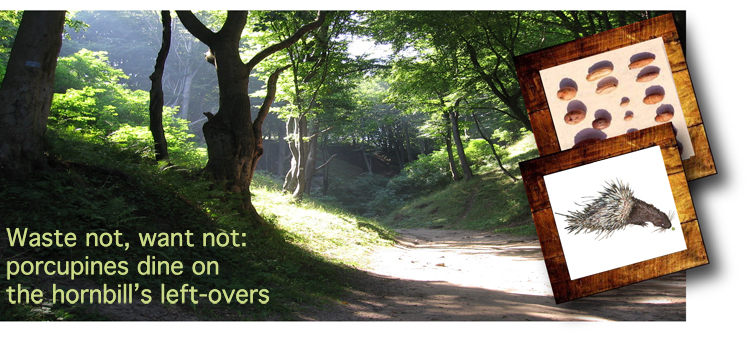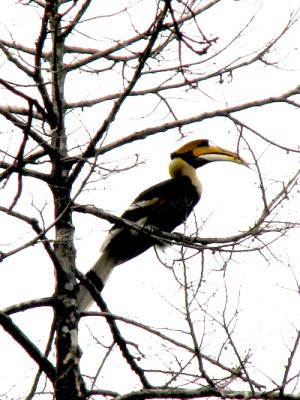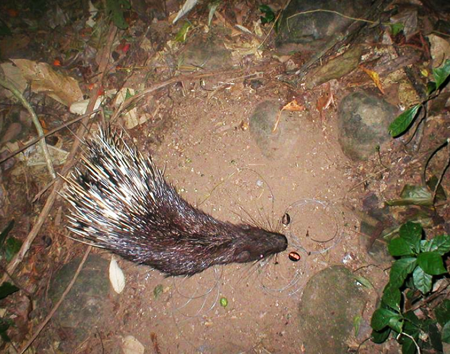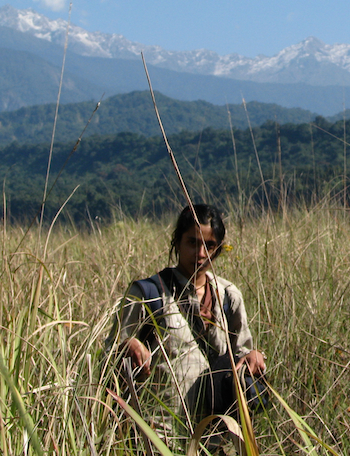Waste not, want not: porcupines dine on the hornbill's leftovers
In an Indian tropical forest there are few things as distinctive and exciting as the swoosh of a hornbill flying overhead. The rushing sound of its heavy wings feels so loud and close that it captures all your attention, then leaves you relieved that the bird had no malevolent intent. Of course if you are lucky enough to also see one of India's nine hornbill species, there is excitement too, all of them being adorned with disproportionately large hooked bills, augmented yet again, in some species, by a striking bony casque.
Hornbills are central to the life of many tropical forests of the world, often dispersing the seeds of many of their tree species. Tropical trees commonly engage animals in seed dispersal - relying on wind or gravity is not so successful when the vegetation is dense. The hornbills eat the tasty flesh that surround the seeds, which are then regurgitated or left behind in the droppings.But hornbill-utilising trees have another trick up their sleeves. The seeds, while not of interest to the hornbills themselves, are often rich in fats and attract other potential dispersers, primarily rodents. In tropical forests of the Americas it has been shown that rodents do not always eat all the seeds immediately, but cache some of them underground for later use. But these secret stores are often forgotten, and so the seeds find themselves in a perfect location for germination. The survival of the Brazil Nut tree, for example, relies heavily on the caching behaviour of the red rumped agouti.
Up until recently no-one had looked at whether the rodents of India's tropical forests play a similar role in this second round of seed dispersal. It was a question perfectly matched to Nandini Velho, a graduate of Mumbai University with a long-standing interest in plant-animal interdependency. As a student in the M.Sc Wildlife program at NCBS (run together with the Wildlife Conservation Society-India and the Centre for Wildlife Studies) Nandini's research took her far from Bangalore to the north-east reaches of India, where she set up camp in the Himalayan foothills of Pakke Tiger Reserve in the East Kameng district of Arunachal Pradesh.
Pakke Tiger Reserve was an ideal choice for her study. A quarter of its tropical tree species produce fruits eaten by the three hornbill species of the region (Great Indian Hornbill, Oriental Pied Hornbill, Wreathed Hornbill). To test if the numerous rodents of the area were interested in the seeds, Nandini studied the fate of seeds either under the fruit-producing trees themselves, or under the trees in which the hornbills roost. She found that unless she protected the area around a tree with a rodent-excluding metal barrier, seeds did indeed disappear at a great rate, an average of 65% being preyed upon across five different tree species. Using motion-activated cameras to detect the night-time raiders, she found the most common culprits were the two largest rodents of Pakke: the Himalayan crestless porcupine and brush-tailed porcupine.
So the stage was set to answer the big question: did the Indian rodents take the lead of their American counterparts and hide some of the seeds in underground caches? By very careful tracking of her seeds, Nandini was able to show that the answer to this question was basically, no. Less than 1.5% of seeds were cached, with the rodents not being fans of the theory of delayed gratification. Nandini believes this different pattern may result from there being less reason for Indian rodents to cache their food if Indian tropical forests are less seasonal than those of the Americas, and thus provide a more constant supply of suitable food.
It was a demanding study, just getting the cameras to do their job properly took several weeks of tweaking. Amusingly, analysing the photos was complicated by many limelight-grabbing small birds, who, while uninterested in the seeds, were happy to pose for the trigger-happy camera traps. Once Nandini had settled into her routines a different type of visitor made their presence felt. As she says: “I began to make time for the kids who were curious about this new ‘scientist didi’ (sister in Hindi). It wasn’t long before I started teaching the kids English every evening at my field station. I’d have a minimum of six kids at home every evening.”
Nandini's approach was straighforward but has yielded important insights into India's tropical forests. As one of her batch-mates explains: “Some conservation biologists get hijacked by their views and try to advocate a certain paradigm of conservation as being the best method, and then the tools become the end itself and not a means to an end. Nandini is very clear that the aim is to conserve wildlife.” Her results have now been published in the Journal of Tropical Ecology, and she is now busy on a second paper from her thesis work, examining how rodent seed predation affects the distribution of the parent trees within the forests of Pakke. Presently she is a junior research fellow at the National Centre for Biological Sciences.




Comments
Post new comment